Leading and Managing Nonprofit Organizations: Theories and Practices
VerifiedAdded on 2021/02/19
|9
|2405
|43
Report
AI Summary
This report delves into the critical aspects of leading and managing nonprofit organizations, using Action on Poverty as a case study. It examines the importance of leadership, quality management, and stakeholder engagement, highlighting how theories can be applied to improve performance and achieve sustainable development. The report discusses key elements of leadership, governance options, and strategies, including the application of stakeholder theory to address challenges and enhance relationships with employees, members, volunteers, beneficiaries, donors, and the local community. It analyzes the impact of changes in organizational planning, governance vision, and management practices. The report concludes by emphasizing the significance of adapting to evolving practices and adopting the right strategies to drive social welfare and development, offering valuable insights for nonprofit leaders and managers. The report references Andriof, Waddock, Bonnafous-Boucher, Rendtorff, Johnson-Cramer, Berman, Post, Jones, Harrison, Felps, Lankoski, Smith, Van Wassenhove, Magill, Quinzii, Rochet, Miles, Missonier, Loufrani-Fedida, Wasieleski, and Windsor.
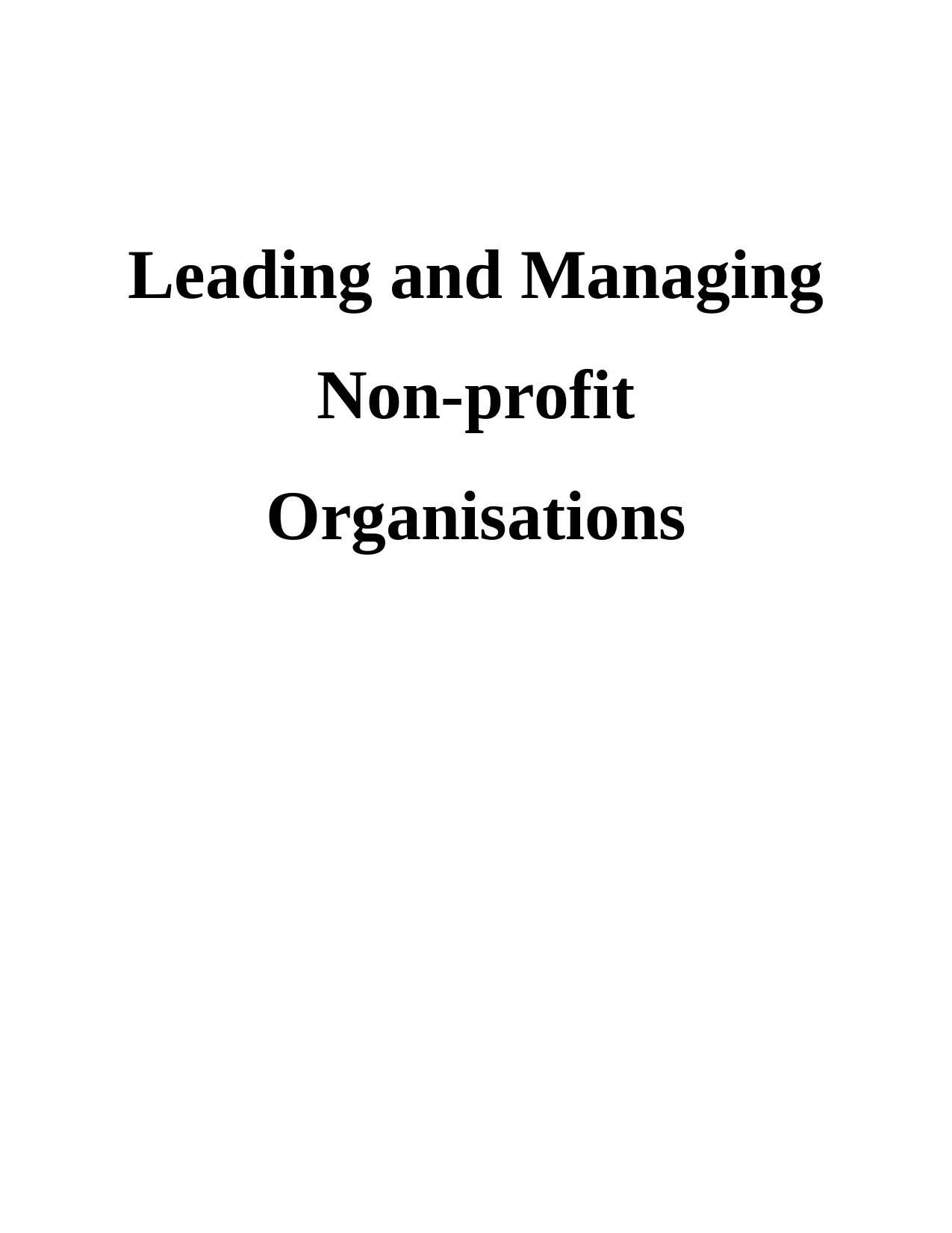
Leading and Managing
Non-profit
Organisations
Non-profit
Organisations
Paraphrase This Document
Need a fresh take? Get an instant paraphrase of this document with our AI Paraphraser
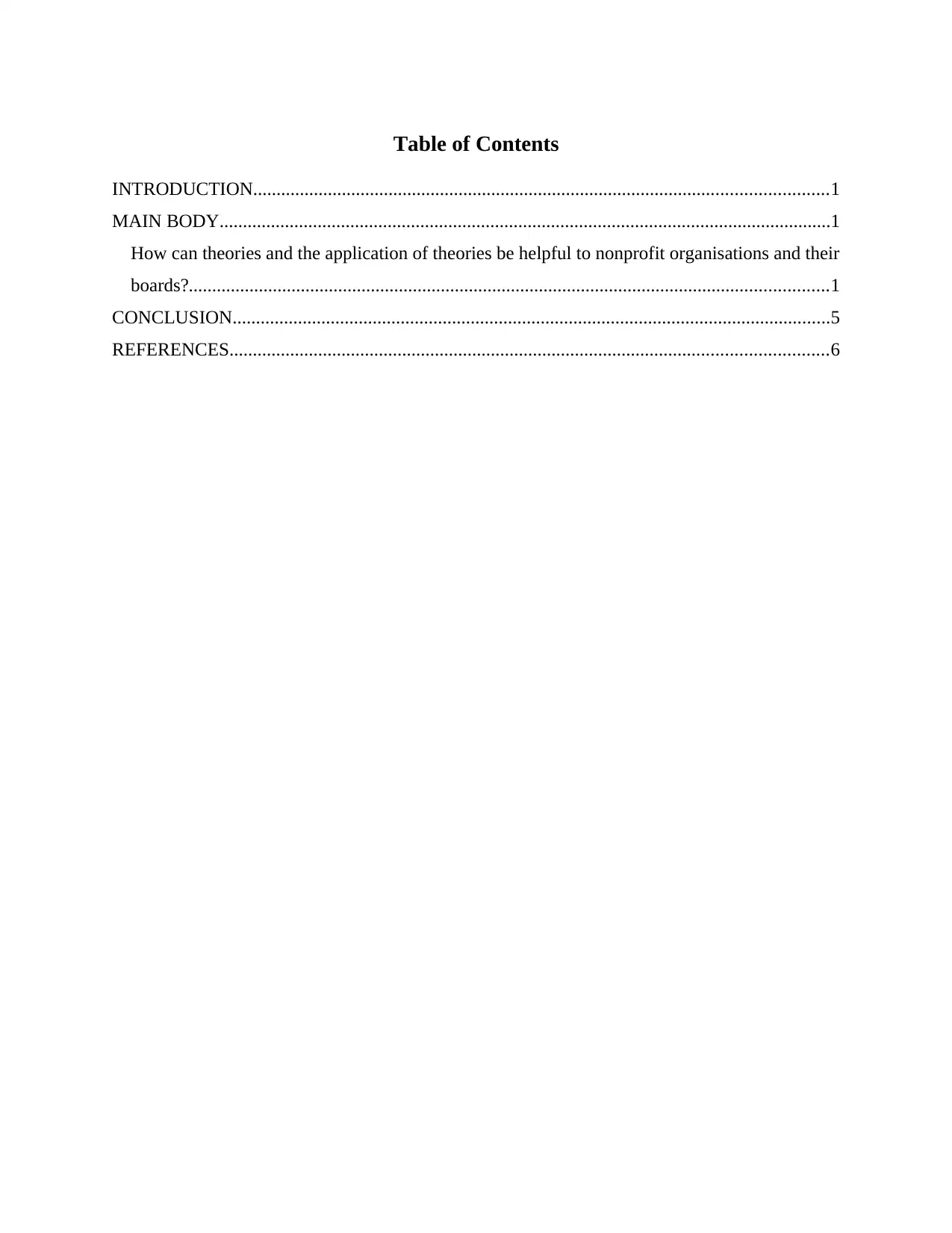
Table of Contents
INTRODUCTION...........................................................................................................................1
MAIN BODY...................................................................................................................................1
How can theories and the application of theories be helpful to nonprofit organisations and their
boards?.........................................................................................................................................1
CONCLUSION................................................................................................................................5
REFERENCES................................................................................................................................6
INTRODUCTION...........................................................................................................................1
MAIN BODY...................................................................................................................................1
How can theories and the application of theories be helpful to nonprofit organisations and their
boards?.........................................................................................................................................1
CONCLUSION................................................................................................................................5
REFERENCES................................................................................................................................6
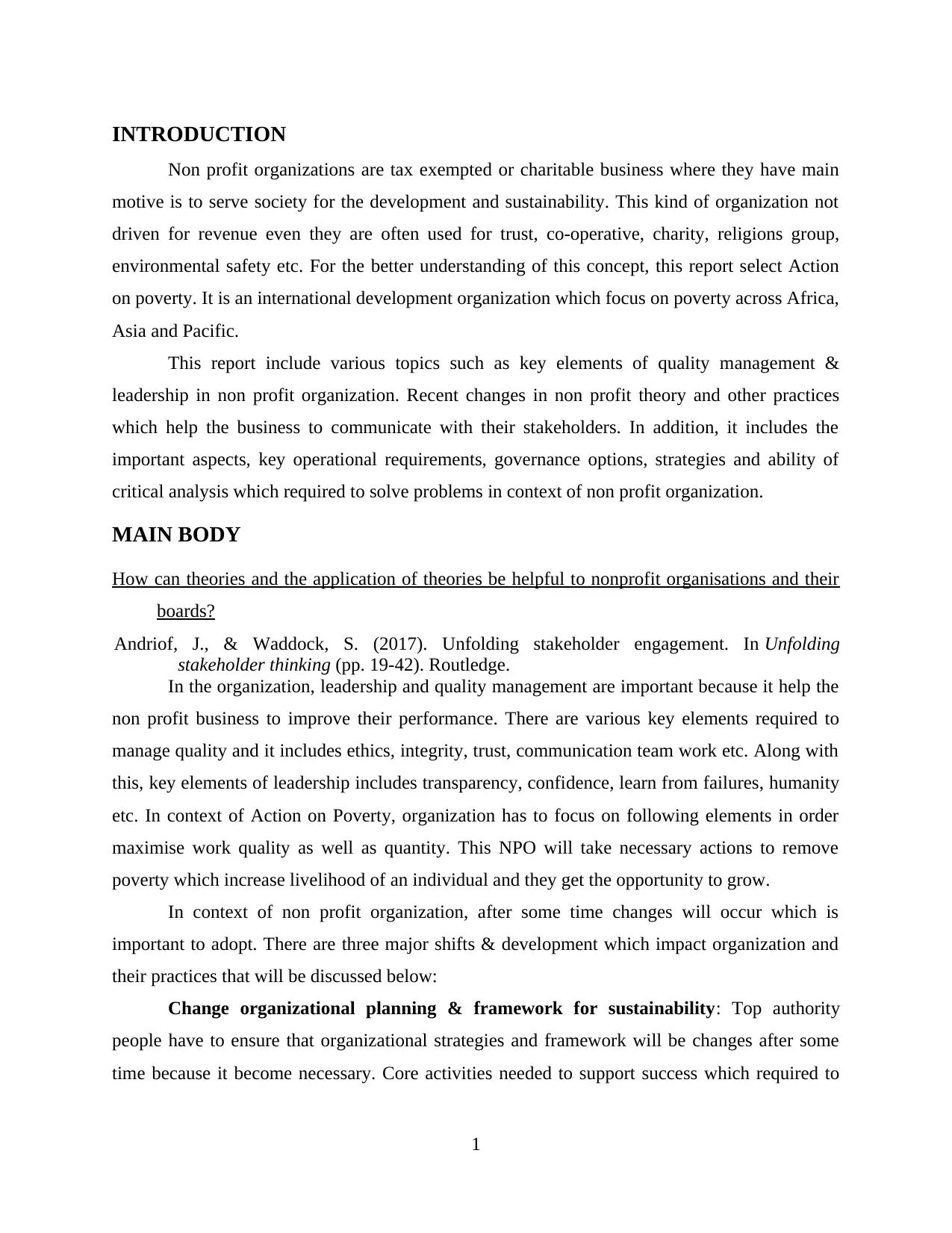
INTRODUCTION
Non profit organizations are tax exempted or charitable business where they have main
motive is to serve society for the development and sustainability. This kind of organization not
driven for revenue even they are often used for trust, co-operative, charity, religions group,
environmental safety etc. For the better understanding of this concept, this report select Action
on poverty. It is an international development organization which focus on poverty across Africa,
Asia and Pacific.
This report include various topics such as key elements of quality management &
leadership in non profit organization. Recent changes in non profit theory and other practices
which help the business to communicate with their stakeholders. In addition, it includes the
important aspects, key operational requirements, governance options, strategies and ability of
critical analysis which required to solve problems in context of non profit organization.
MAIN BODY
How can theories and the application of theories be helpful to nonprofit organisations and their
boards?
Andriof, J., & Waddock, S. (2017). Unfolding stakeholder engagement. In Unfolding
stakeholder thinking (pp. 19-42). Routledge.
In the organization, leadership and quality management are important because it help the
non profit business to improve their performance. There are various key elements required to
manage quality and it includes ethics, integrity, trust, communication team work etc. Along with
this, key elements of leadership includes transparency, confidence, learn from failures, humanity
etc. In context of Action on Poverty, organization has to focus on following elements in order
maximise work quality as well as quantity. This NPO will take necessary actions to remove
poverty which increase livelihood of an individual and they get the opportunity to grow.
In context of non profit organization, after some time changes will occur which is
important to adopt. There are three major shifts & development which impact organization and
their practices that will be discussed below:
Change organizational planning & framework for sustainability: Top authority
people have to ensure that organizational strategies and framework will be changes after some
time because it become necessary. Core activities needed to support success which required to
1
Non profit organizations are tax exempted or charitable business where they have main
motive is to serve society for the development and sustainability. This kind of organization not
driven for revenue even they are often used for trust, co-operative, charity, religions group,
environmental safety etc. For the better understanding of this concept, this report select Action
on poverty. It is an international development organization which focus on poverty across Africa,
Asia and Pacific.
This report include various topics such as key elements of quality management &
leadership in non profit organization. Recent changes in non profit theory and other practices
which help the business to communicate with their stakeholders. In addition, it includes the
important aspects, key operational requirements, governance options, strategies and ability of
critical analysis which required to solve problems in context of non profit organization.
MAIN BODY
How can theories and the application of theories be helpful to nonprofit organisations and their
boards?
Andriof, J., & Waddock, S. (2017). Unfolding stakeholder engagement. In Unfolding
stakeholder thinking (pp. 19-42). Routledge.
In the organization, leadership and quality management are important because it help the
non profit business to improve their performance. There are various key elements required to
manage quality and it includes ethics, integrity, trust, communication team work etc. Along with
this, key elements of leadership includes transparency, confidence, learn from failures, humanity
etc. In context of Action on Poverty, organization has to focus on following elements in order
maximise work quality as well as quantity. This NPO will take necessary actions to remove
poverty which increase livelihood of an individual and they get the opportunity to grow.
In context of non profit organization, after some time changes will occur which is
important to adopt. There are three major shifts & development which impact organization and
their practices that will be discussed below:
Change organizational planning & framework for sustainability: Top authority
people have to ensure that organizational strategies and framework will be changes after some
time because it become necessary. Core activities needed to support success which required to
1
⊘ This is a preview!⊘
Do you want full access?
Subscribe today to unlock all pages.

Trusted by 1+ million students worldwide
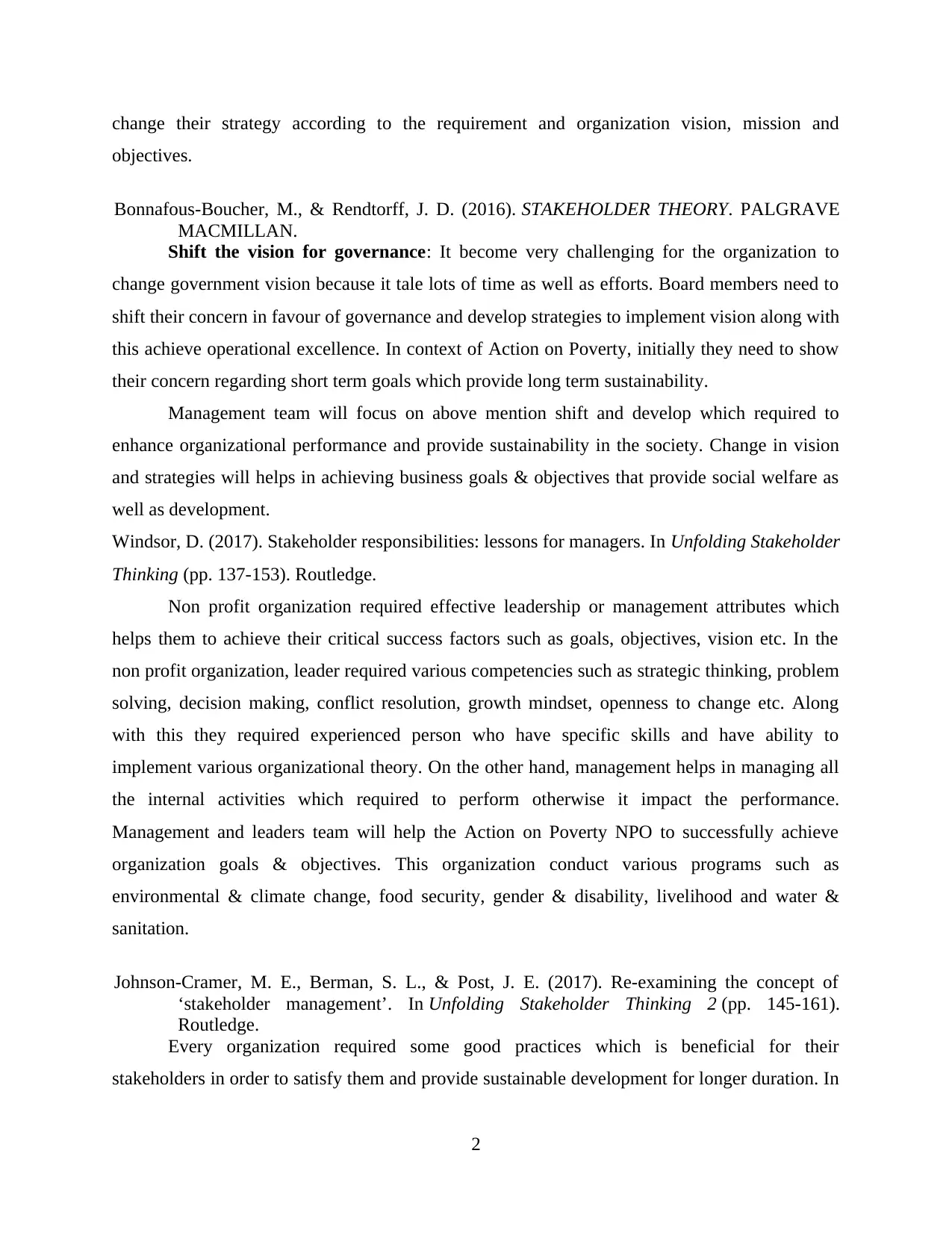
change their strategy according to the requirement and organization vision, mission and
objectives.
Bonnafous-Boucher, M., & Rendtorff, J. D. (2016). STAKEHOLDER THEORY. PALGRAVE
MACMILLAN.
Shift the vision for governance: It become very challenging for the organization to
change government vision because it tale lots of time as well as efforts. Board members need to
shift their concern in favour of governance and develop strategies to implement vision along with
this achieve operational excellence. In context of Action on Poverty, initially they need to show
their concern regarding short term goals which provide long term sustainability.
Management team will focus on above mention shift and develop which required to
enhance organizational performance and provide sustainability in the society. Change in vision
and strategies will helps in achieving business goals & objectives that provide social welfare as
well as development.
Windsor, D. (2017). Stakeholder responsibilities: lessons for managers. In Unfolding Stakeholder
Thinking (pp. 137-153). Routledge.
Non profit organization required effective leadership or management attributes which
helps them to achieve their critical success factors such as goals, objectives, vision etc. In the
non profit organization, leader required various competencies such as strategic thinking, problem
solving, decision making, conflict resolution, growth mindset, openness to change etc. Along
with this they required experienced person who have specific skills and have ability to
implement various organizational theory. On the other hand, management helps in managing all
the internal activities which required to perform otherwise it impact the performance.
Management and leaders team will help the Action on Poverty NPO to successfully achieve
organization goals & objectives. This organization conduct various programs such as
environmental & climate change, food security, gender & disability, livelihood and water &
sanitation.
Johnson-Cramer, M. E., Berman, S. L., & Post, J. E. (2017). Re-examining the concept of
‘stakeholder management’. In Unfolding Stakeholder Thinking 2 (pp. 145-161).
Routledge.
Every organization required some good practices which is beneficial for their
stakeholders in order to satisfy them and provide sustainable development for longer duration. In
2
objectives.
Bonnafous-Boucher, M., & Rendtorff, J. D. (2016). STAKEHOLDER THEORY. PALGRAVE
MACMILLAN.
Shift the vision for governance: It become very challenging for the organization to
change government vision because it tale lots of time as well as efforts. Board members need to
shift their concern in favour of governance and develop strategies to implement vision along with
this achieve operational excellence. In context of Action on Poverty, initially they need to show
their concern regarding short term goals which provide long term sustainability.
Management team will focus on above mention shift and develop which required to
enhance organizational performance and provide sustainability in the society. Change in vision
and strategies will helps in achieving business goals & objectives that provide social welfare as
well as development.
Windsor, D. (2017). Stakeholder responsibilities: lessons for managers. In Unfolding Stakeholder
Thinking (pp. 137-153). Routledge.
Non profit organization required effective leadership or management attributes which
helps them to achieve their critical success factors such as goals, objectives, vision etc. In the
non profit organization, leader required various competencies such as strategic thinking, problem
solving, decision making, conflict resolution, growth mindset, openness to change etc. Along
with this they required experienced person who have specific skills and have ability to
implement various organizational theory. On the other hand, management helps in managing all
the internal activities which required to perform otherwise it impact the performance.
Management and leaders team will help the Action on Poverty NPO to successfully achieve
organization goals & objectives. This organization conduct various programs such as
environmental & climate change, food security, gender & disability, livelihood and water &
sanitation.
Johnson-Cramer, M. E., Berman, S. L., & Post, J. E. (2017). Re-examining the concept of
‘stakeholder management’. In Unfolding Stakeholder Thinking 2 (pp. 145-161).
Routledge.
Every organization required some good practices which is beneficial for their
stakeholders in order to satisfy them and provide sustainable development for longer duration. In
2
Paraphrase This Document
Need a fresh take? Get an instant paraphrase of this document with our AI Paraphraser
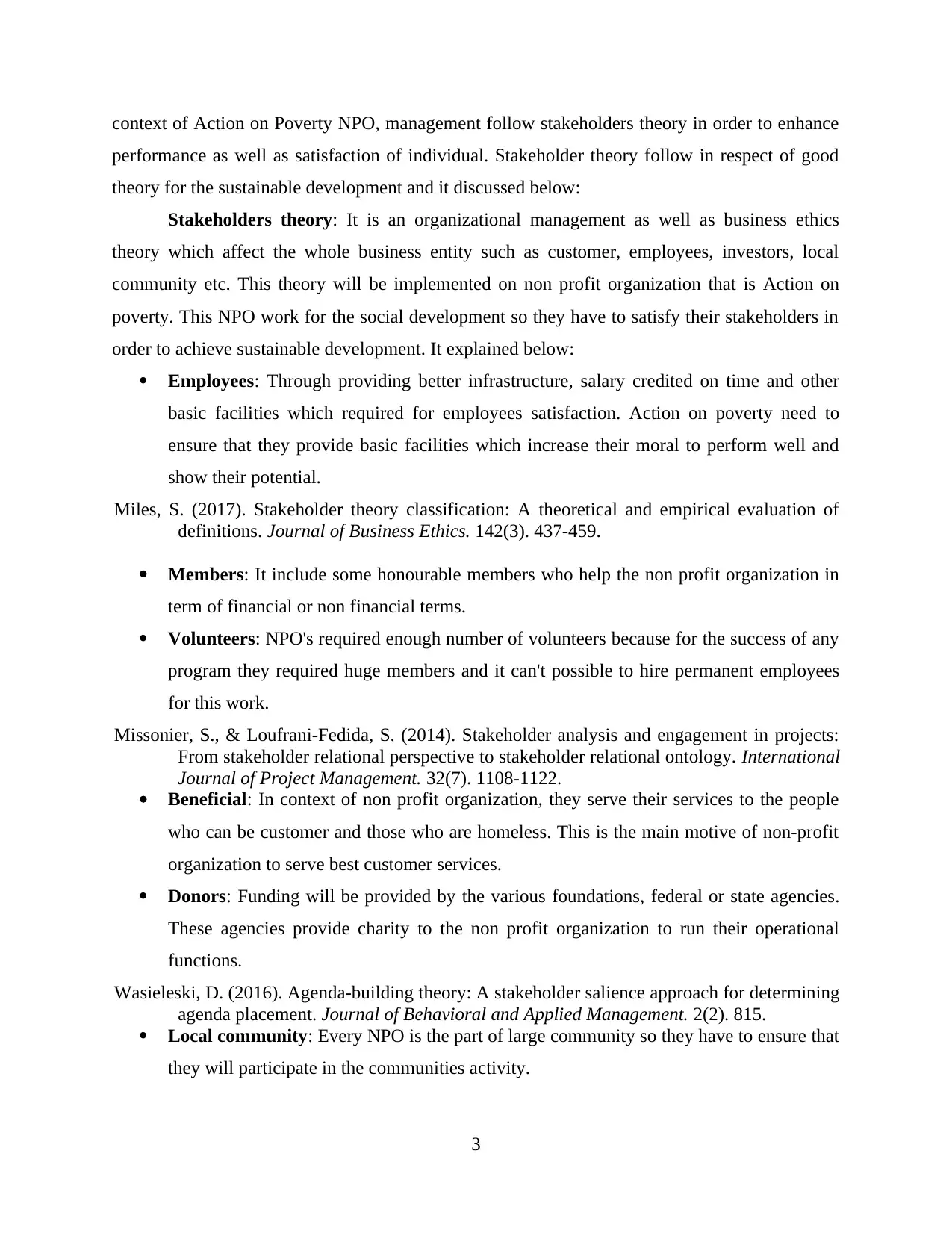
context of Action on Poverty NPO, management follow stakeholders theory in order to enhance
performance as well as satisfaction of individual. Stakeholder theory follow in respect of good
theory for the sustainable development and it discussed below:
Stakeholders theory: It is an organizational management as well as business ethics
theory which affect the whole business entity such as customer, employees, investors, local
community etc. This theory will be implemented on non profit organization that is Action on
poverty. This NPO work for the social development so they have to satisfy their stakeholders in
order to achieve sustainable development. It explained below:
Employees: Through providing better infrastructure, salary credited on time and other
basic facilities which required for employees satisfaction. Action on poverty need to
ensure that they provide basic facilities which increase their moral to perform well and
show their potential.
Miles, S. (2017). Stakeholder theory classification: A theoretical and empirical evaluation of
definitions. Journal of Business Ethics. 142(3). 437-459.
Members: It include some honourable members who help the non profit organization in
term of financial or non financial terms.
Volunteers: NPO's required enough number of volunteers because for the success of any
program they required huge members and it can't possible to hire permanent employees
for this work.
Missonier, S., & Loufrani-Fedida, S. (2014). Stakeholder analysis and engagement in projects:
From stakeholder relational perspective to stakeholder relational ontology. International
Journal of Project Management. 32(7). 1108-1122.
Beneficial: In context of non profit organization, they serve their services to the people
who can be customer and those who are homeless. This is the main motive of non-profit
organization to serve best customer services.
Donors: Funding will be provided by the various foundations, federal or state agencies.
These agencies provide charity to the non profit organization to run their operational
functions.
Wasieleski, D. (2016). Agenda-building theory: A stakeholder salience approach for determining
agenda placement. Journal of Behavioral and Applied Management. 2(2). 815.
Local community: Every NPO is the part of large community so they have to ensure that
they will participate in the communities activity.
3
performance as well as satisfaction of individual. Stakeholder theory follow in respect of good
theory for the sustainable development and it discussed below:
Stakeholders theory: It is an organizational management as well as business ethics
theory which affect the whole business entity such as customer, employees, investors, local
community etc. This theory will be implemented on non profit organization that is Action on
poverty. This NPO work for the social development so they have to satisfy their stakeholders in
order to achieve sustainable development. It explained below:
Employees: Through providing better infrastructure, salary credited on time and other
basic facilities which required for employees satisfaction. Action on poverty need to
ensure that they provide basic facilities which increase their moral to perform well and
show their potential.
Miles, S. (2017). Stakeholder theory classification: A theoretical and empirical evaluation of
definitions. Journal of Business Ethics. 142(3). 437-459.
Members: It include some honourable members who help the non profit organization in
term of financial or non financial terms.
Volunteers: NPO's required enough number of volunteers because for the success of any
program they required huge members and it can't possible to hire permanent employees
for this work.
Missonier, S., & Loufrani-Fedida, S. (2014). Stakeholder analysis and engagement in projects:
From stakeholder relational perspective to stakeholder relational ontology. International
Journal of Project Management. 32(7). 1108-1122.
Beneficial: In context of non profit organization, they serve their services to the people
who can be customer and those who are homeless. This is the main motive of non-profit
organization to serve best customer services.
Donors: Funding will be provided by the various foundations, federal or state agencies.
These agencies provide charity to the non profit organization to run their operational
functions.
Wasieleski, D. (2016). Agenda-building theory: A stakeholder salience approach for determining
agenda placement. Journal of Behavioral and Applied Management. 2(2). 815.
Local community: Every NPO is the part of large community so they have to ensure that
they will participate in the communities activity.
3
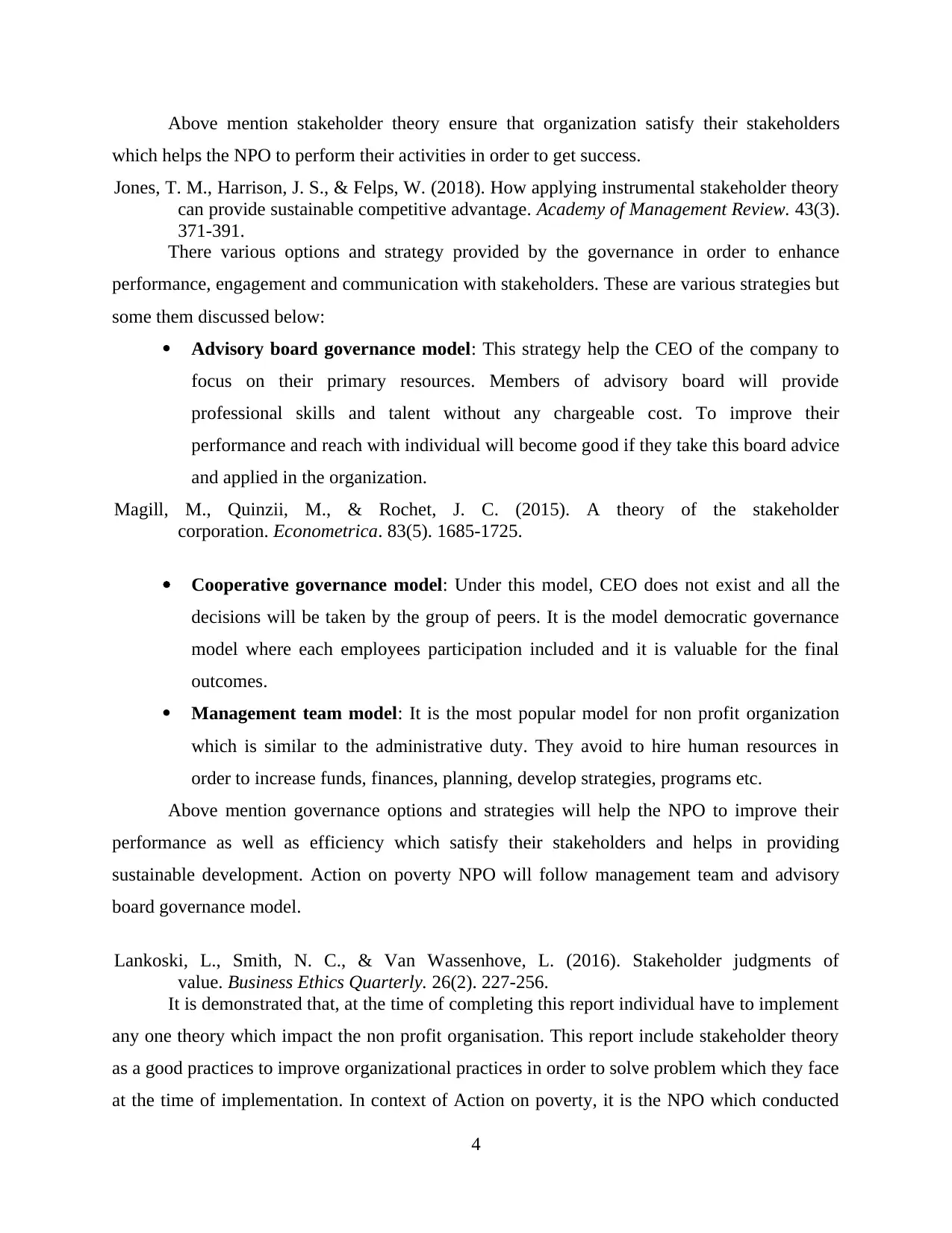
Above mention stakeholder theory ensure that organization satisfy their stakeholders
which helps the NPO to perform their activities in order to get success.
Jones, T. M., Harrison, J. S., & Felps, W. (2018). How applying instrumental stakeholder theory
can provide sustainable competitive advantage. Academy of Management Review. 43(3).
371-391.
There various options and strategy provided by the governance in order to enhance
performance, engagement and communication with stakeholders. These are various strategies but
some them discussed below:
Advisory board governance model: This strategy help the CEO of the company to
focus on their primary resources. Members of advisory board will provide
professional skills and talent without any chargeable cost. To improve their
performance and reach with individual will become good if they take this board advice
and applied in the organization.
Magill, M., Quinzii, M., & Rochet, J. C. (2015). A theory of the stakeholder
corporation. Econometrica. 83(5). 1685-1725.
Cooperative governance model: Under this model, CEO does not exist and all the
decisions will be taken by the group of peers. It is the model democratic governance
model where each employees participation included and it is valuable for the final
outcomes.
Management team model: It is the most popular model for non profit organization
which is similar to the administrative duty. They avoid to hire human resources in
order to increase funds, finances, planning, develop strategies, programs etc.
Above mention governance options and strategies will help the NPO to improve their
performance as well as efficiency which satisfy their stakeholders and helps in providing
sustainable development. Action on poverty NPO will follow management team and advisory
board governance model.
Lankoski, L., Smith, N. C., & Van Wassenhove, L. (2016). Stakeholder judgments of
value. Business Ethics Quarterly. 26(2). 227-256.
It is demonstrated that, at the time of completing this report individual have to implement
any one theory which impact the non profit organisation. This report include stakeholder theory
as a good practices to improve organizational practices in order to solve problem which they face
at the time of implementation. In context of Action on poverty, it is the NPO which conducted
4
which helps the NPO to perform their activities in order to get success.
Jones, T. M., Harrison, J. S., & Felps, W. (2018). How applying instrumental stakeholder theory
can provide sustainable competitive advantage. Academy of Management Review. 43(3).
371-391.
There various options and strategy provided by the governance in order to enhance
performance, engagement and communication with stakeholders. These are various strategies but
some them discussed below:
Advisory board governance model: This strategy help the CEO of the company to
focus on their primary resources. Members of advisory board will provide
professional skills and talent without any chargeable cost. To improve their
performance and reach with individual will become good if they take this board advice
and applied in the organization.
Magill, M., Quinzii, M., & Rochet, J. C. (2015). A theory of the stakeholder
corporation. Econometrica. 83(5). 1685-1725.
Cooperative governance model: Under this model, CEO does not exist and all the
decisions will be taken by the group of peers. It is the model democratic governance
model where each employees participation included and it is valuable for the final
outcomes.
Management team model: It is the most popular model for non profit organization
which is similar to the administrative duty. They avoid to hire human resources in
order to increase funds, finances, planning, develop strategies, programs etc.
Above mention governance options and strategies will help the NPO to improve their
performance as well as efficiency which satisfy their stakeholders and helps in providing
sustainable development. Action on poverty NPO will follow management team and advisory
board governance model.
Lankoski, L., Smith, N. C., & Van Wassenhove, L. (2016). Stakeholder judgments of
value. Business Ethics Quarterly. 26(2). 227-256.
It is demonstrated that, at the time of completing this report individual have to implement
any one theory which impact the non profit organisation. This report include stakeholder theory
as a good practices to improve organizational practices in order to solve problem which they face
at the time of implementation. In context of Action on poverty, it is the NPO which conducted
4
⊘ This is a preview!⊘
Do you want full access?
Subscribe today to unlock all pages.

Trusted by 1+ million students worldwide
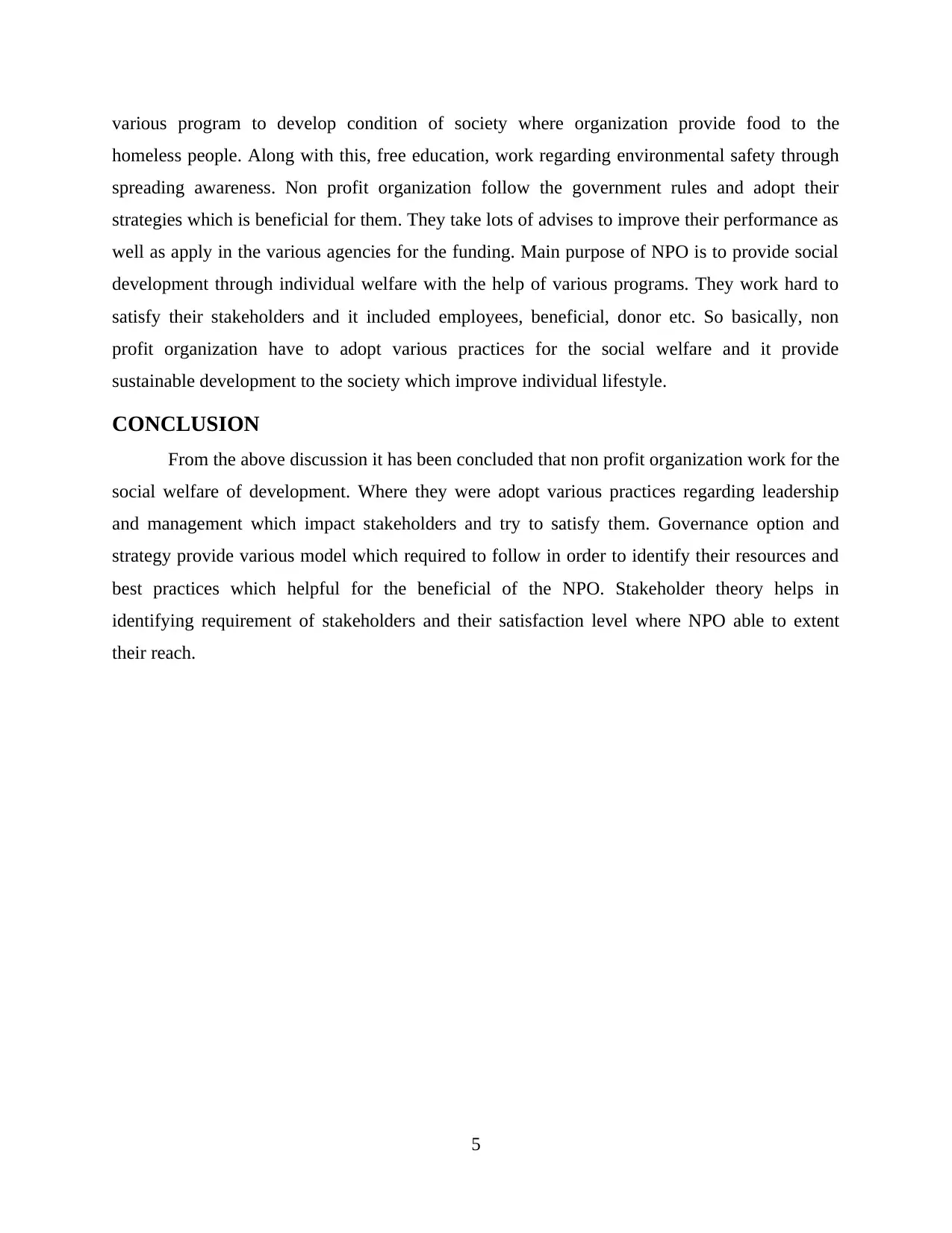
various program to develop condition of society where organization provide food to the
homeless people. Along with this, free education, work regarding environmental safety through
spreading awareness. Non profit organization follow the government rules and adopt their
strategies which is beneficial for them. They take lots of advises to improve their performance as
well as apply in the various agencies for the funding. Main purpose of NPO is to provide social
development through individual welfare with the help of various programs. They work hard to
satisfy their stakeholders and it included employees, beneficial, donor etc. So basically, non
profit organization have to adopt various practices for the social welfare and it provide
sustainable development to the society which improve individual lifestyle.
CONCLUSION
From the above discussion it has been concluded that non profit organization work for the
social welfare of development. Where they were adopt various practices regarding leadership
and management which impact stakeholders and try to satisfy them. Governance option and
strategy provide various model which required to follow in order to identify their resources and
best practices which helpful for the beneficial of the NPO. Stakeholder theory helps in
identifying requirement of stakeholders and their satisfaction level where NPO able to extent
their reach.
5
homeless people. Along with this, free education, work regarding environmental safety through
spreading awareness. Non profit organization follow the government rules and adopt their
strategies which is beneficial for them. They take lots of advises to improve their performance as
well as apply in the various agencies for the funding. Main purpose of NPO is to provide social
development through individual welfare with the help of various programs. They work hard to
satisfy their stakeholders and it included employees, beneficial, donor etc. So basically, non
profit organization have to adopt various practices for the social welfare and it provide
sustainable development to the society which improve individual lifestyle.
CONCLUSION
From the above discussion it has been concluded that non profit organization work for the
social welfare of development. Where they were adopt various practices regarding leadership
and management which impact stakeholders and try to satisfy them. Governance option and
strategy provide various model which required to follow in order to identify their resources and
best practices which helpful for the beneficial of the NPO. Stakeholder theory helps in
identifying requirement of stakeholders and their satisfaction level where NPO able to extent
their reach.
5
Paraphrase This Document
Need a fresh take? Get an instant paraphrase of this document with our AI Paraphraser
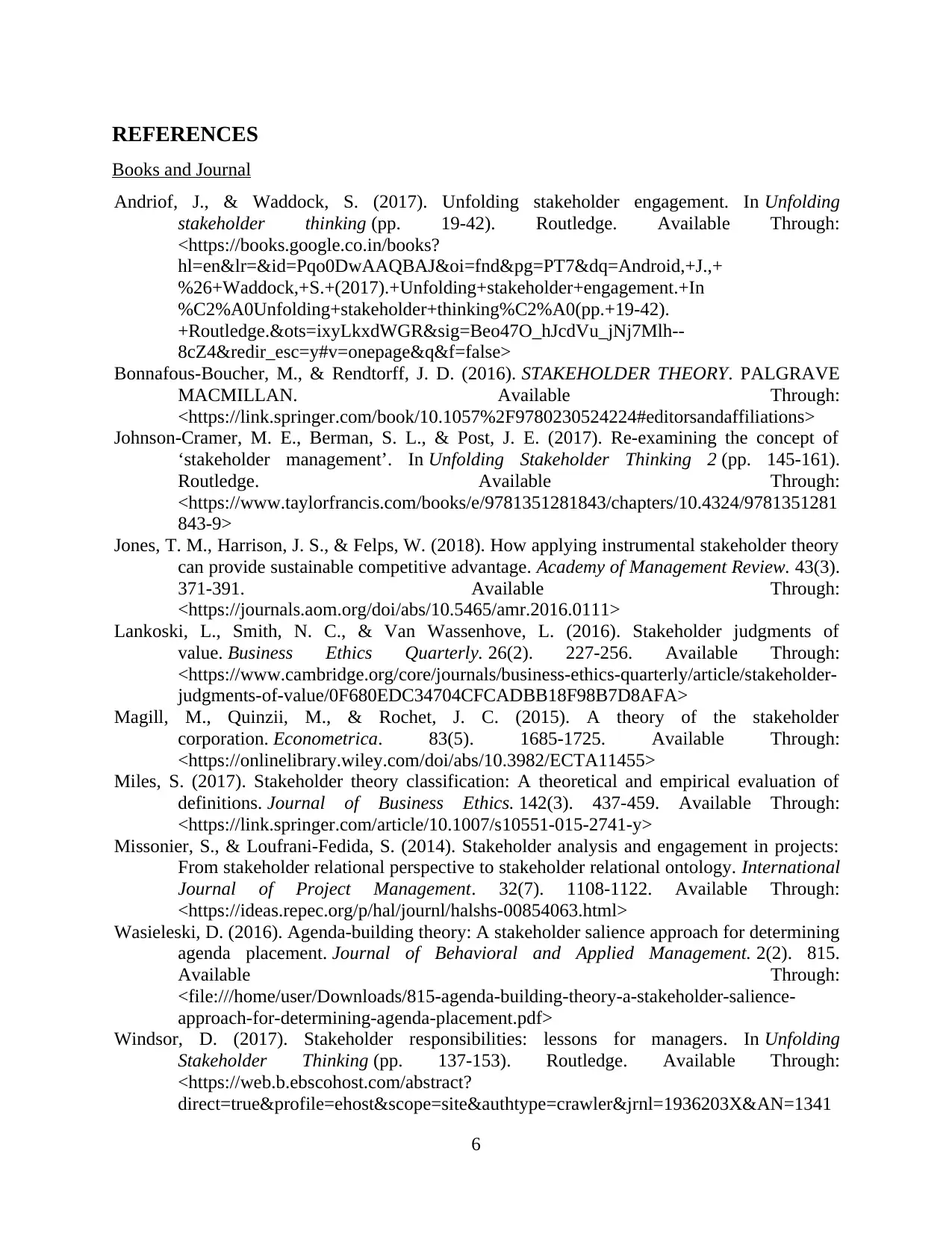
REFERENCES
Books and Journal
Andriof, J., & Waddock, S. (2017). Unfolding stakeholder engagement. In Unfolding
stakeholder thinking (pp. 19-42). Routledge. Available Through:
<https://books.google.co.in/books?
hl=en&lr=&id=Pqo0DwAAQBAJ&oi=fnd&pg=PT7&dq=Android,+J.,+
%26+Waddock,+S.+(2017).+Unfolding+stakeholder+engagement.+In
%C2%A0Unfolding+stakeholder+thinking%C2%A0(pp.+19-42).
+Routledge.&ots=ixyLkxdWGR&sig=Beo47O_hJcdVu_jNj7Mlh--
8cZ4&redir_esc=y#v=onepage&q&f=false>
Bonnafous-Boucher, M., & Rendtorff, J. D. (2016). STAKEHOLDER THEORY. PALGRAVE
MACMILLAN. Available Through:
<https://link.springer.com/book/10.1057%2F9780230524224#editorsandaffiliations>
Johnson-Cramer, M. E., Berman, S. L., & Post, J. E. (2017). Re-examining the concept of
‘stakeholder management’. In Unfolding Stakeholder Thinking 2 (pp. 145-161).
Routledge. Available Through:
<https://www.taylorfrancis.com/books/e/9781351281843/chapters/10.4324/9781351281
843-9>
Jones, T. M., Harrison, J. S., & Felps, W. (2018). How applying instrumental stakeholder theory
can provide sustainable competitive advantage. Academy of Management Review. 43(3).
371-391. Available Through:
<https://journals.aom.org/doi/abs/10.5465/amr.2016.0111>
Lankoski, L., Smith, N. C., & Van Wassenhove, L. (2016). Stakeholder judgments of
value. Business Ethics Quarterly. 26(2). 227-256. Available Through:
<https://www.cambridge.org/core/journals/business-ethics-quarterly/article/stakeholder-
judgments-of-value/0F680EDC34704CFCADBB18F98B7D8AFA>
Magill, M., Quinzii, M., & Rochet, J. C. (2015). A theory of the stakeholder
corporation. Econometrica. 83(5). 1685-1725. Available Through:
<https://onlinelibrary.wiley.com/doi/abs/10.3982/ECTA11455>
Miles, S. (2017). Stakeholder theory classification: A theoretical and empirical evaluation of
definitions. Journal of Business Ethics. 142(3). 437-459. Available Through:
<https://link.springer.com/article/10.1007/s10551-015-2741-y>
Missonier, S., & Loufrani-Fedida, S. (2014). Stakeholder analysis and engagement in projects:
From stakeholder relational perspective to stakeholder relational ontology. International
Journal of Project Management. 32(7). 1108-1122. Available Through:
<https://ideas.repec.org/p/hal/journl/halshs-00854063.html>
Wasieleski, D. (2016). Agenda-building theory: A stakeholder salience approach for determining
agenda placement. Journal of Behavioral and Applied Management. 2(2). 815.
Available Through:
<file:///home/user/Downloads/815-agenda-building-theory-a-stakeholder-salience-
approach-for-determining-agenda-placement.pdf>
Windsor, D. (2017). Stakeholder responsibilities: lessons for managers. In Unfolding
Stakeholder Thinking (pp. 137-153). Routledge. Available Through:
<https://web.b.ebscohost.com/abstract?
direct=true&profile=ehost&scope=site&authtype=crawler&jrnl=1936203X&AN=1341
6
Books and Journal
Andriof, J., & Waddock, S. (2017). Unfolding stakeholder engagement. In Unfolding
stakeholder thinking (pp. 19-42). Routledge. Available Through:
<https://books.google.co.in/books?
hl=en&lr=&id=Pqo0DwAAQBAJ&oi=fnd&pg=PT7&dq=Android,+J.,+
%26+Waddock,+S.+(2017).+Unfolding+stakeholder+engagement.+In
%C2%A0Unfolding+stakeholder+thinking%C2%A0(pp.+19-42).
+Routledge.&ots=ixyLkxdWGR&sig=Beo47O_hJcdVu_jNj7Mlh--
8cZ4&redir_esc=y#v=onepage&q&f=false>
Bonnafous-Boucher, M., & Rendtorff, J. D. (2016). STAKEHOLDER THEORY. PALGRAVE
MACMILLAN. Available Through:
<https://link.springer.com/book/10.1057%2F9780230524224#editorsandaffiliations>
Johnson-Cramer, M. E., Berman, S. L., & Post, J. E. (2017). Re-examining the concept of
‘stakeholder management’. In Unfolding Stakeholder Thinking 2 (pp. 145-161).
Routledge. Available Through:
<https://www.taylorfrancis.com/books/e/9781351281843/chapters/10.4324/9781351281
843-9>
Jones, T. M., Harrison, J. S., & Felps, W. (2018). How applying instrumental stakeholder theory
can provide sustainable competitive advantage. Academy of Management Review. 43(3).
371-391. Available Through:
<https://journals.aom.org/doi/abs/10.5465/amr.2016.0111>
Lankoski, L., Smith, N. C., & Van Wassenhove, L. (2016). Stakeholder judgments of
value. Business Ethics Quarterly. 26(2). 227-256. Available Through:
<https://www.cambridge.org/core/journals/business-ethics-quarterly/article/stakeholder-
judgments-of-value/0F680EDC34704CFCADBB18F98B7D8AFA>
Magill, M., Quinzii, M., & Rochet, J. C. (2015). A theory of the stakeholder
corporation. Econometrica. 83(5). 1685-1725. Available Through:
<https://onlinelibrary.wiley.com/doi/abs/10.3982/ECTA11455>
Miles, S. (2017). Stakeholder theory classification: A theoretical and empirical evaluation of
definitions. Journal of Business Ethics. 142(3). 437-459. Available Through:
<https://link.springer.com/article/10.1007/s10551-015-2741-y>
Missonier, S., & Loufrani-Fedida, S. (2014). Stakeholder analysis and engagement in projects:
From stakeholder relational perspective to stakeholder relational ontology. International
Journal of Project Management. 32(7). 1108-1122. Available Through:
<https://ideas.repec.org/p/hal/journl/halshs-00854063.html>
Wasieleski, D. (2016). Agenda-building theory: A stakeholder salience approach for determining
agenda placement. Journal of Behavioral and Applied Management. 2(2). 815.
Available Through:
<file:///home/user/Downloads/815-agenda-building-theory-a-stakeholder-salience-
approach-for-determining-agenda-placement.pdf>
Windsor, D. (2017). Stakeholder responsibilities: lessons for managers. In Unfolding
Stakeholder Thinking (pp. 137-153). Routledge. Available Through:
<https://web.b.ebscohost.com/abstract?
direct=true&profile=ehost&scope=site&authtype=crawler&jrnl=1936203X&AN=1341
6

09922&h=9x8cAPeeqBN3bUrVhqVYd7XRH3ac8R5wpWfoOPshcTi
%2bUXEqBO5SzAmRk9wUh0CO2U4MxgaPthXJtySLMjpENg%3d
%3d&crl=c&resultNs=AdminWebAuth&resultLocal=ErrCrlNotAuth&crlhashurl=login
.aspx%3fdirect%3dtrue%26profile%3dehost%26scope%3dsite%26authtype%3dcrawler
%26jrnl%3d1936203X%26AN%3d134109922>
7
%2bUXEqBO5SzAmRk9wUh0CO2U4MxgaPthXJtySLMjpENg%3d
%3d&crl=c&resultNs=AdminWebAuth&resultLocal=ErrCrlNotAuth&crlhashurl=login
.aspx%3fdirect%3dtrue%26profile%3dehost%26scope%3dsite%26authtype%3dcrawler
%26jrnl%3d1936203X%26AN%3d134109922>
7
⊘ This is a preview!⊘
Do you want full access?
Subscribe today to unlock all pages.

Trusted by 1+ million students worldwide
1 out of 9
Related Documents
Your All-in-One AI-Powered Toolkit for Academic Success.
+13062052269
info@desklib.com
Available 24*7 on WhatsApp / Email
![[object Object]](/_next/static/media/star-bottom.7253800d.svg)
Unlock your academic potential
Copyright © 2020–2025 A2Z Services. All Rights Reserved. Developed and managed by ZUCOL.




